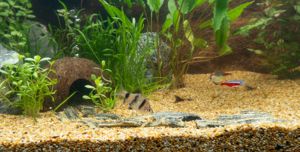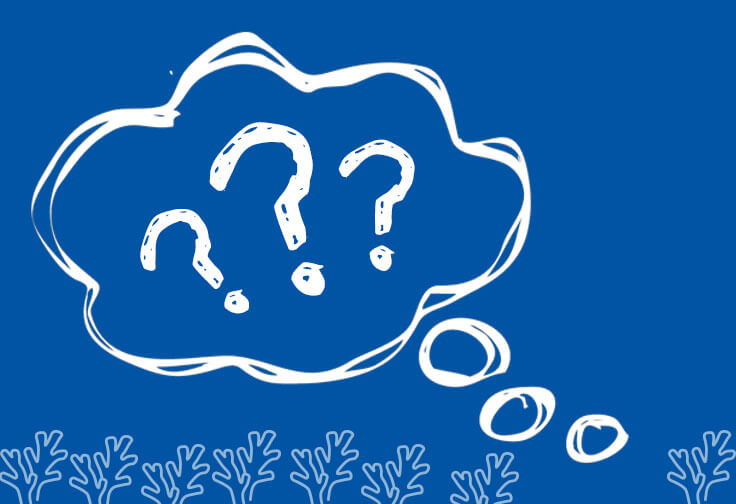What should I feed my aquarium fish?
The most important factor to consider when feeding aquarium fish is providing them with a balanced diet. This means selecting a variety of food sources in order to provide all the right nutrients for your fish. A wide range of commercial foods are available, such as flakes and pellets,
Look out for the words “complete food” on the label of your fish food. This means the food contains all the required nutrition your fish needs to be healthy.
See our feeding your fish article for more information.
What are the main types of fish food?
Flake
Flake food is commonly used to provide a balanced diet for herbivorous, omnivorous and carnivorous fish. Made up of small, thin pieces of fish food, they contain essential vitamins and minerals to promote healthy growth.
Freeze-dried
Typically comes in small cubes, dispersing in the water when added to an aquarium. They can also be available as whole-creatures, such as bloodworms, brine shrimp, and krill. Whatever your choice, all can provide the nutrients your fish need to stay healthy.
Sinking Pellets or Wafers
Sinking pellets or wafers are ideal for bottom-dwelling fish that feed from the substrate. They sink to the bottom of the tank and provide a nutritious diet for your fish. So all you have to do is simply add them to your aquarium and allow them to sink.
Floating Pellets
Floating pellets are a great option for fish that feed from the surface of the aquarium. They float on top of the water, allowing your fish to easily locate and consume them. Have a look at your fish’s mouth – when the bottom lip extends past the top lip giving it an upturned mouth, this often indicates that the fish naturally would feed from the surface.
These pellets contain key nutrients, vitamins and minerals. This includes proteins for carnivorous fish or plant-based ingredients for herbivores. Plus, you won’t have to worry about mess, as they are designed not to cloud the water.
Tablets
Ideal for mid-water community fish like tetras and barbs. Some types of tablet foods can be stuck to the glass of the tank, allowing your fish to easily consume them.
Frozen
Frozen foods are a great way to add variety to your aquarium’s diet. They are available in ice-cube-like trays and other forms. Although less convenient, frozen foods can help to support a great diet for your fish.
Fresh Foods
Your fish can also thrive on a diet of fresh food. Try adding greens such as lettuce, peas, and courgette to the tank for them to feed on. Not only does it add variety to their diet, but it also helps deter herbivorous fish from nibbling on your aquarium plants.
However, be sure to remove any uneaten food from the tank before it starts to decay and affects the water quality. This will help keep the water clean and free from toxins that can harm your fish.
How often should I feed my fish?
Feeding your fish is an important part of caring for them, so it’s important to know how often they should be fed. Generally speaking, most fish only need to be fed once or twice a day, with two smaller meals allowing for better digestion and less water pollution.
On the other hand, growing baby fish and slow grazers may need constant access to food and can benefit from being given three to five small meals or a long-lasting food every day.
What is the best time to feed fish?
The best time to feed your fish is in the morning, when they are the most active. This will ensure that they get enough energy and nutrition throughout the day.
Make sure to remove any uneaten food after about 10 minutes, as this can quickly lead to water pollution if left for too long. Additionally, it’s important not to feed your fish more than they can consume in one feeding session.
How do I know if my fish is hungry?
In order to determine if your fish are hungry, it is important to observe their behaviour.
Signs of hunger can include:
- Your fish dig at the substrate searching for food.
- Changes in your fish’s behaviours, such as aggression
- Waiting at the top of the aquarium for feeding time.
- Notable changes in size and weight.
- Lethargy
To get a better understanding of your fish’s eating habits, you can try feeding them small amounts at 2-3 intervals throughout the day. After two minutes, be sure to remove any leftover food. Doing this for a few days will help you gauge how much and how frequently they like to be fed.
How long can fish go without food?
Fish can usually go three days to two weeks without eating, depending on the species. Generally, it is best not to withhold food from your fish for any longer than this, as it can lead to health issues.
Additionally, when going on holiday, an automatic fish feeder can be used to ensure your fish’s diet is kept consistent.
How can you tell if you are overfeeding your fish?
Finding the ideal balance is key. Overfeeding can cause serious issues in an aquarium and is much more common than underfeeding. To keep your fish healthy, gauge who is feeding them, and remember that it’s better to underfeed than to overfeed. Also, remove any leftover food quickly to prevent it from contaminating the water.
Some signs of overfeeding include:
- Begging for food (typically seen in freshwater tropical fish and goldfish)
- Pellets floating on the surface
- Cloudy water
- High levels of ammonia and nitrite in the water
- Excessive algae growth
- Food has sunk to the bottom
- Poor water quality
If you see any of these signs, reduce the amount of food you are feeding your fish and remove any uneaten food. If the problem persists, seek advice from a qualified aquarium expert.
Do I need an automatic fish feeder?
An automatic fish feeder can be a useful tool for anyone looking to maintain the health of their aquarium. These devices allow you to feed your fish on a regular basis, handy when you go away on holiday.
With an automatic fish feeder, you can set the exact amount of food to be dispensed at specific times. This can help to ensure that your fish are being fed correct amounts at regular intervals.
Which Automatic Fish Feeder is Best?
When it comes to choosing the best automatic fish feeder, there are a few factors to consider. First, you should look for one that is reliable and can accurately dispense the correct amount of food. Additionally, the feeder should be easy to set up and program.
Some models even have features like adjustable portion sizes, timers, and alarms to alert you when it’s time to feed your fish. It’s important to choose the right automatic fish feeder for your aquarium, as this will ensure that your fish are receiving the correct amount of food.
Feeding your aquarium fish correctly is an important part of keeping them healthy. Make sure to know who is feeding them, as well as how often they should be fed and what type of food they need.
For more information, see our further questions regarding aquarium fish feeding.





